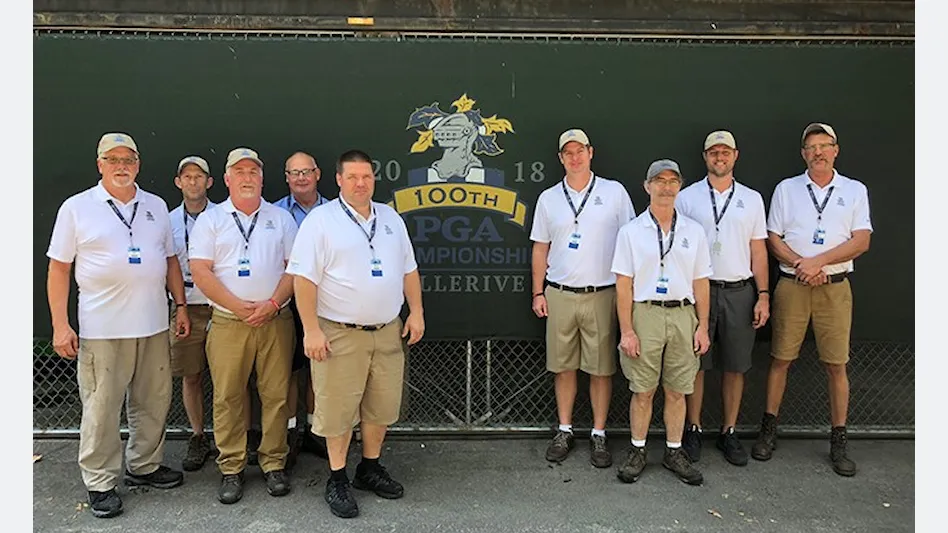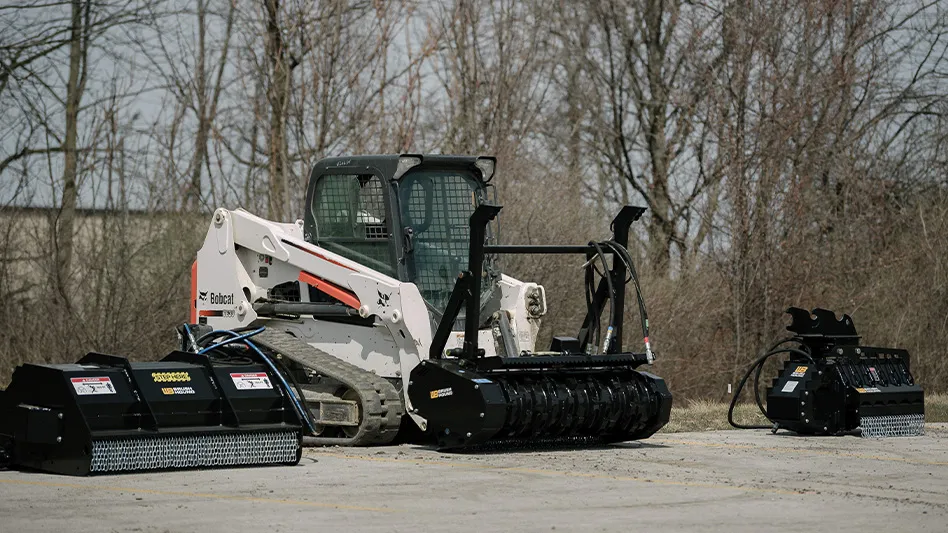
Preparing a golf course with cool- and warm-season turf varieties for a major championship requires dozens of extra bodies. It also requires extra equipment.
On the morning before the first round of the 100th PGA Championship, Bellerive Country Club equipment manager Chris Rapp begins describes the supersized numbers.
The big stuff includes nine fairway mowers, seven tee and approach mowers, two intermediate mowers four step cuts, five rough mowers, 18 walking greens mowers, and four mowers for cleanups and collars.
“How many mowers is that?” he asks. Rapp pauses and continues. “Not to mention the carts,” he adds. “There are probably 60 to 70 electric and gas carts down here.”
Doubling a mower fleet and quadrupling the cart fleet has turned equipment maintenance into nearly a 24-hour activity at Bellerive. The club has two technician shifts. The first crew works from 3:30 a.m. to 1:30 p.m. The second crew works from 11 a.m. to 9 p.m. Like all things associated with a major championship, the hours are subject to change and likely to expand. “The quality of cut aspect of this whole thing … It’s the 100th PGA Championship,” Rapp says. “It has to be as close to perfect as we can possibly get it.”
Rapp, fortunately, has plenty of help. His crew includes assistant Jim McCool and intern Codie Stroup. Rapp’s passion for golf equipment maintenance and the industry connections led to Bellerive securing four advance week and 13 tournament volunteers. The equipment technicians have their own lounge inside Bellerive’s maintenance facility, although they spend tournament days on their feet, sharpening, grinding and inspecting equipment.
Information is exchanged inside the shop and on the course. Equipment technicians cover the front and back nines during on-course maintenance shifts to ensure mowers are functioning properly.
“An important part of the job is getting out on the golf course and seeing that the machines we are setting up and sharpening are doing what they are supposed to be doing,” Rapp says. “The more eyes we have out there looking, especially experienced eyes, the better. It’s a big golf course. It’s almost impossible for any one person to scan every square foot of it.”
How big is Bellerive? Director of agronomy and grounds Carlos Arraya says the crew mows more than 160 acres of turf. The total includes four acres of bentgrass greens and 30 acres of zoysiagrass fairways. Zoysiagrass flourishes in Transition Zone heat, but it tests equipment.
“Zoysia is a fairly tough grass,” Rapp says. “We are basically using four fairways mowers on each fairway at a time. Having all four of those machines look identical creates a challenge. It’s not complicated, but it takes time.”
Securing volunteers during advance week and equipment support from John Deere eased the tension associated with a major championship. The additional personnel resulted in the pre-tournament grinding of 136 cutting units. Rapp is working his fourth televised tournament since arriving at Bellerive in 2003 and he’s volunteered at numerous other events.
A St. Louis native, Rapp says there’s a “serious” vibe to being responsible for the equipment preparing a course for the region’s first major championship in 26 years. But Rapp strives to keep an energetic vibe inside the shop by playing music, informally chatting with volunteers and giving an occasional motivational speech.
“He does a great job of bringing the guys together and recognizing that we are here to have fun and we are here to try to focus on making the golf course great and making this a great place to work,” Arraya says.
Rapp networks like a successful superintendent and his connections allowed Bellerive to quickly secure 20 squeegees from neighboring facilities following a 1 ½-inch dousing Tuesday. He’s hoping the major championship spotlight not only provides a jolt to St. Louis and Bellerive but helps attract determined young people to the profession.
“I love getting up and coming to the golf course,” he says. “I want to share that with other people and help the future of our business.”
Guy Cipriano is GCI’s senior editor.
On the morning before the first round of the 100th PGA Championship, Bellerive Country Club equipment manager Chris Rapp begins describes the supersized numbers.
The big stuff includes nine fairway mowers, seven tee and approach mowers, two intermediate mowers four step cuts, five rough mowers, 18 walking greens mowers, and four mowers for cleanups and collars.
“How many mowers is that?” he asks. Rapp pauses and continues. “Not to mention the carts,” he adds. “There are probably 60 to 70 electric and gas carts down here.”
Doubling a mower fleet and quadrupling the cart fleet has turned equipment maintenance into nearly a 24-hour activity at Bellerive. The club has two technician shifts. The first crew works from 3:30 a.m. to 1:30 p.m. The second crew works from 11 a.m. to 9 p.m. Like all things associated with a major championship, the hours are subject to change and likely to expand. “The quality of cut aspect of this whole thing … It’s the 100th PGA Championship,” Rapp says. “It has to be as close to perfect as we can possibly get it.”
Rapp, fortunately, has plenty of help. His crew includes assistant Jim McCool and intern Codie Stroup. Rapp’s passion for golf equipment maintenance and the industry connections led to Bellerive securing four advance week and 13 tournament volunteers. The equipment technicians have their own lounge inside Bellerive’s maintenance facility, although they spend tournament days on their feet, sharpening, grinding and inspecting equipment.
Information is exchanged inside the shop and on the course. Equipment technicians cover the front and back nines during on-course maintenance shifts to ensure mowers are functioning properly.
“An important part of the job is getting out on the golf course and seeing that the machines we are setting up and sharpening are doing what they are supposed to be doing,” Rapp says. “The more eyes we have out there looking, especially experienced eyes, the better. It’s a big golf course. It’s almost impossible for any one person to scan every square foot of it.”
How big is Bellerive? Director of agronomy and grounds Carlos Arraya says the crew mows more than 160 acres of turf. The total includes four acres of bentgrass greens and 30 acres of zoysiagrass fairways. Zoysiagrass flourishes in Transition Zone heat, but it tests equipment.
“Zoysia is a fairly tough grass,” Rapp says. “We are basically using four fairways mowers on each fairway at a time. Having all four of those machines look identical creates a challenge. It’s not complicated, but it takes time.”
Securing volunteers during advance week and equipment support from John Deere eased the tension associated with a major championship. The additional personnel resulted in the pre-tournament grinding of 136 cutting units. Rapp is working his fourth televised tournament since arriving at Bellerive in 2003 and he’s volunteered at numerous other events.
A St. Louis native, Rapp says there’s a “serious” vibe to being responsible for the equipment preparing a course for the region’s first major championship in 26 years. But Rapp strives to keep an energetic vibe inside the shop by playing music, informally chatting with volunteers and giving an occasional motivational speech.
“He does a great job of bringing the guys together and recognizing that we are here to have fun and we are here to try to focus on making the golf course great and making this a great place to work,” Arraya says.
Rapp networks like a successful superintendent and his connections allowed Bellerive to quickly secure 20 squeegees from neighboring facilities following a 1 ½-inch dousing Tuesday. He’s hoping the major championship spotlight not only provides a jolt to St. Louis and Bellerive but helps attract determined young people to the profession.
“I love getting up and coming to the golf course,” he says. “I want to share that with other people and help the future of our business.”
Guy Cipriano is GCI’s senior editor.
Latest from Golf Course Industry
- Devising safer landings
- SiteOne adds Durentis to product offerings
- Resilia available for purchase in Hawaii
- What can $1 million do for expanding the industry workforce?
- Captivating short course debuts on Captiva Island
- Wonderful Women of Golf 35: Carol Turner
- The Andersons acquires Reed & Perrine Sales
- Excel Leadership Program awards six new graduates





